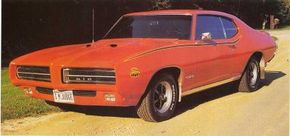Pontiac muscle cars can easily be traced to the hot 389- and 421-cid-powered full-size models that tore up dragstrips and boulevards alike in the early 1960s.
But Pontiac's lasting claim to muscle car fame stems from a bit of mix-and-match that appeared on Poncho order sheets for the 1964 model year. It was a stroke of marketing genius that earned Pontiac credit for initiating the classic era of the muscle car.
Advertisement
Pontiac wasn't the first to place one of its largest engines (a 389-cid V-8) into an intermediate-size car (the Tempest). It was the first to sugar coat the whole thing with bucket seats, heavy-duty suspension, hood scoops, and all the other cues that screamed "cool car" to the nation's young adults.
Pontiac called it the GTO. It stood for Gran Turismo Omologato, an Italian term generally meaning a car suitable for both racing and street use. That Ferrari also offered a car bearing the GTO tag didn't hurt the image.
The GTO was as much image campaign as muscle car, and was part of Pontiac's early-'60s push to reverse the stodgy impression of the brand left over from the 1950s.
Pontiac had begun that makeover with the 1962 and '63 Super Duty Catalinas, midsize cars with a race-prepped 421-cid V-8 and aluminum front sheetmetal. When the Grand Prix debuted in 1962, it also affected a sporty sort of luxury and offered Tri-Power carburetion as an option.
But the GTO was the breakthrough, and its success forced every other General Motors division -- indeed, every other American automaker -- to create midsize muscle cars of their own. The GTO arrived with a four-barrel 325-bhp, 389 V-8. An option with triple two-barrel carburetors was rated at 348 horses. Ram Air was introduced in 1965, and a handsome new body was rolled out for 1966. The 389 and Tri-Power option lasted through 1966, after which the larger 400-cid V-8 took over. The 1966 GTO was the most popular ever, with sales of more than 96,000 units.
By 1967, the GTO was bracketed above by Pontiac's 2+2 (a sporty version of the full-size Catalina) and below by the new Firebird. The Firebird was Pontiac's version of the Chevrolet Camaro and part of GM's response to the Ford's Mustang. Firebird was pitched slightly upscale of the Camaro but gave away little in muscle presence.
The '67 Firebird's performance engines included a High Output 326-cid V-8 rated at 285 bhp, and the 400 HO, rated at 325 horsepower. In 1968, the 326 was replaced with a 350-cid V-8 rated at 320 bhp in HO form, while the Formula 400 had up to 335 ponies.
For 1968, the GTO/Tempest line received a curvaceous new body. In 1969, Pontiac introduced one of the most memorable GTOs ever: the striped and spoilered Judge. Its standard Ram Air 400 was rated at 366 bhp. Also in 1969, Pontiac built the first Firebird Trans Am, although only 697 saw the light of day.
The big news for 1970 was Firebird's swoopy redesign and the availability of the 455-cid V-8 in the GTO. The following year, GM engines lost horsepower, as they were made compatible with unleaded gas. That marked the beginning of the end for many muscle cars.
But while some manufacturers killed theirs off quickly, the true believers at Pontiac kept the flame burning into 2002 with the Firebird Trans Am. It flickered anew for 2004 when Pontiac took a midsize coupe from GM's Australian branch and christened it the new GTO. The car's Corvette V-8 power gave it muscle-car performance, but the U.S. performance-car market never warmed up to the car as worthy of bearing the name of the muscle car that started it all back in 1964.
Return to Muscle Car Information Library.
For more cool information on muscle cars, check out:
- Muscle cars came in many shapes and sizes. Here are features on more than 100 muscle cars, including photos and specifications for each model.
- Muscle cars created their own culture. To learn about it, read How Muscle Cars Work.
For more profiles, photos, and specifications of Pontiac muscle cars, see:
- With race-quality 405-bhp V-8, the 1962 Pontiac Catalina Super Duty 421 was fearsome on the street and superior at the strip.
- The 1964 Tempest GTO lit the fuse on the muscle car boom by giving the small-car, big-engine ethic a cool identity.
- It's hard to improve on an original, but new styling and more power helped the 1965 Pontiac Tempest GTO do just that.
- Big, beautiful, and beastly, the 1966 Pontiac 2+2 showed the midsize muscle leader could do full-size performance, too.
- The 1966 Pontiac GTO rode its shapely new styling and 360-bhp V-8 to unequalled muscle car popularity.
- In comparison tests, the 1968 Pontiac Firebird 400 beat pony car rivals from AMC, Ford, Mercury, Plymouth, and even Chevy.
- The 1968 Pontiac GTO got curvaceous new sheet metal and was available with Pontiac's unique energy-absorbing Endura front bumper.
- Unsung but not unassuming, the 1969 Pontiac Firebird Trans Am was the blueprint for one of America's most enduring muscle cars.
- Loads of go-fast goodies came standard on the striped and spoilered 1969 Pontiac GTO Judge.
- The 1970 Pontiac Firebird Trans Am combined sports-car handling and muscle car power.
- Packing a 455-cid V-8, the 1971 Pontiac Firebird Trans Am featured the biggest engine ever put in a pony car.
Advertisement
